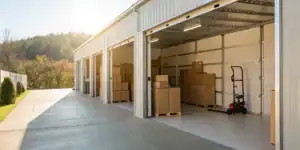Your car is a significant investment, and protecting it is just smart ownership. Sun, rain, snow, and extreme temperatures can take a toll on your vehicle’s paint, interior, and mechanical parts over time. If you don’t have a garage or need to store your car long-term, finding the right protection is key. This is exactly why self storage for cars exists—to preserve your vehicle’s condition and value. Choosing the right option means considering factors like security, climate control, and cost. We’ll explore all of these details to help you make an informed decision and ensure your car stays in top shape while it’s stored away.
Key Takeaways
- Choose the right level of protection: Your car’s value and your local climate should guide your choice between outdoor, covered, or indoor storage. A daily driver might be fine with a covered spot, but a classic car will thank you for a climate-controlled unit.
- Prep your car to avoid costly surprises: Don’t just park it and forget it. A thorough cleaning, a full tank of stabilized fuel, properly inflated tires, and a battery tender are essential steps to ensure your car is in great shape when you return.
- Look beyond the monthly rate: The best facility offers strong security features like gated access and cameras. Before signing, confirm the total cost by asking about one-time fees and mandatory insurance to avoid hidden expenses.
What Is Car Storage?
Think of car storage as a personal garage away from home. It’s a secure, rented space where you can park your vehicle for any length of time, whether you need it for a month during a move or for an entire season. If you’re short on driveway space, going on an extended trip, or just want to protect a classic car from the elements, a dedicated storage spot can be a lifesaver. It gives you peace of mind knowing your vehicle is safe and sound until you need it again.
The basics of car storage
At its core, car storage is a service offered by self-storage facilities to keep your vehicle secure. You can find a range of options, from a simple outdoor parking spot to a fully enclosed, climate-controlled unit. Many companies offer flexible, month-to-month rentals, so you’re not locked into a long-term contract. Depending on the facility, you might be able to park your car in a designated outdoor lot, under a covered carport, or inside a drive-up unit. These enclosed spaces offer the same protection as a personal garage, keeping your vehicle completely sheltered from the outside.
When does car storage make sense?
You might consider car storage for several reasons. It’s a fantastic way to protect your vehicle from harsh weather, whether it’s blistering summer sun or a winter full of snow and ice. It’s also a great solution if you’re dealing with limited parking at your home or apartment complex. Many people use car storage during long-term travel or military deployment to ensure their vehicle stays safe. If you own a seasonal vehicle, like a convertible or a classic car that you only drive in the summer, storage keeps it protected during the off-season. The cost of car storage can vary widely based on location and type, but it’s often a small price to pay for security and convenience.
Your Car Storage Options
When you decide to store your car, you’ll find a few different options available. Think of it like parking, but with varying levels of protection and price points. The right choice for you really comes down to your budget, your local climate, and how long you plan to store your vehicle. Are you storing a daily driver for a month during a trip, or are you preserving a classic car for the long haul?
Each type of storage offers a different balance of security, protection from the elements, and cost. An outdoor space is the most basic and affordable, while an indoor, climate-controlled unit provides the highest level of care. Let’s walk through the main types so you can figure out which one fits your needs and gives you peace of mind.
Indoor storage
If you’re looking for the best possible protection for your vehicle, indoor storage is the way to go. These units are located inside a larger building, shielding your car from rain, snow, sun, and wind. This complete enclosure significantly reduces the risk of weather-related damage to your paint and interior.
Another major benefit is enhanced security and cleanliness. An indoor environment is much less accessible to pests like rodents and insects that can wreak havoc on wiring and upholstery. While it’s typically a more expensive option, the investment pays off by keeping your car in the same condition as when you left it. It’s an excellent choice for long-term storage or for any vehicle you value highly.
Outdoor storage
Outdoor storage is essentially a designated parking spot at a storage facility. It’s the most straightforward and budget-friendly option available. You’ll typically find these spaces in a fenced, gated lot with security monitoring. This option is great for larger vehicles like RVs or boats, but it’s also a common choice for cars when cost is the primary concern.
The main trade-off is exposure to the elements. Your car won’t be protected from sun, rain, or hail, so using a high-quality, waterproof car cover is a must. While it doesn’t offer the same level of protection as other options, outdoor storage provides a secure, accessible place to park your car for short-term needs.
Covered storage
Covered storage is the perfect middle ground between indoor and outdoor options. These spaces are typically outdoor spots that have a roof but no walls, like a carport. This setup provides a crucial layer of protection from the most direct threats, like harsh sunlight that can fade your paint and damage your dashboard, as well as rain, hail, and snow.
While your car is still exposed to ambient temperature, humidity, and wind, the overhead cover prevents the most immediate forms of weather damage. It’s a popular and cost-effective choice for people who want more protection than an open parking spot without paying the premium for a fully enclosed indoor unit.
Climate-controlled units
For classic cars, luxury vehicles, or any car with sensitive materials, a climate-controlled unit is the ultimate solution. These are indoor units that go one step further by maintaining a stable temperature and humidity level year-round. Drastic temperature swings can cause materials like leather, wood, and rubber to crack, warp, or degrade over time. High humidity can lead to mold, mildew, and rust.
By keeping the environment stable, climate control prevents these issues, preserving your car’s condition and value. It’s the most expensive option, but it’s a small price to pay to protect a significant investment, especially during long-term storage.
How Much Does Car Storage Cost?
Figuring out the budget for car storage can feel a bit like guessing, but the price isn’t random. The monthly rate you’ll pay depends on a handful of key factors, and knowing what they are will help you find the right spot for your car without overspending. On average, you can expect to pay anywhere from $45 to $450 per month. That’s a huge range, I know! But once you narrow down your specific needs, you’ll get a much clearer picture of your actual costs. Let’s break down what goes into that final price tag.
What affects the price?
The biggest factor influencing your car storage cost is location. A storage unit in a dense urban center will almost always cost more than one in a suburban or rural area. The size of your vehicle also plays a major role—a spot for a compact car will be cheaper than one for a large truck or RV. Beyond that, the type of storage you choose matters. A simple, uncovered outdoor space will be your most affordable option, while an indoor, climate-controlled unit with top-tier security features will sit at the higher end of the price spectrum. Finally, consider the rental duration, as some facilities may offer a slight discount for a longer-term commitment.
Typical costs by storage type
To give you a better idea of what to expect, let’s look at some typical monthly price ranges. A basic outdoor parking spot is the most budget-friendly choice. For more protection from the elements, a covered parking space is a step up. If you want your car fully enclosed, an indoor, drive-up unit typically runs between $160 and $225 per month. For vehicles that need extra protection from humidity and extreme temperature swings, a climate-controlled storage unit is the way to go. These often range from $75 to $225, with the final price depending heavily on the unit’s size and location.
Watch out for hidden fees
The monthly rate you see advertised isn’t always the full story. Before you sign on the dotted line, make sure you ask about any additional costs. Many facilities charge a one-time administrative fee just to get you set up, which is usually around $25 to $30. You’ll also need to factor in the cost of insurance, as most storage companies require you to have it. Some places will sell you a policy, while others let you use your existing car insurance. You might also need to buy a specific type of lock from the facility. Reading the rental agreement carefully and asking questions upfront will help you avoid any financial surprises down the road.
How to Choose the Right Car Storage Facility
Finding the right storage facility for your car is about more than just finding an empty space. You’re looking for a place that will keep your vehicle safe, secure, and in the same condition as when you left it. The best facility for you will depend on your car, your budget, and your peace of mind. To make the right choice, focus on four key areas: security, convenience, climate, and insurance. Getting clear on these points will help you find the perfect spot for your car.
Look for key security features
When you store your car, you’re trusting the facility with a valuable asset. Start by checking out their security measures. A secure facility should have a combination of features working together. Look for proper lighting across the entire property, not just at the entrance. A top-tier facility will have a sophisticated surveillance network with high-resolution cameras covering multiple angles, not just a single, grainy camera. Gated entry that requires a personal access code is also a must-have. These features ensure that only authorized people can enter the property, giving you confidence that your car is well-protected.
Consider access and convenience
Think about how and when you’ll need to get to your car. Many facilities offer 24/7 access, but it’s always best to confirm their hours. Check if they have covered loading and unloading areas, which can be a lifesaver in bad weather. The layout of traditional indoor vs. outdoor storage units can also affect how easy it is to maneuver your vehicle. For ultimate convenience, some companies offer portable storage containers that are delivered directly to you. You can load your car at home, and the container is then moved to a secure warehouse, simplifying the entire process.
Decide if you need climate control
Climate control is a feature that maintains a stable temperature and humidity level inside the storage unit. While it costs a bit more, it can be a worthwhile investment, especially for classic, luxury, or sentimental vehicles. Extreme heat, cold, and moisture can wreak havoc on a car’s interior, electronics, and paint job. If you live in an area with harsh winters or humid summers, climate-controlled storage provides a layer of protection against rust, mildew, and cracked leather or vinyl. It’s the best way to ensure your car stays in pristine condition.
Understand the insurance policy
Don’t assume the storage facility’s insurance has you covered. This is one of the most common misconceptions about self storage. Most facilities require you to have your own insurance, and their policy typically only covers damage to the building itself, not the contents of your unit. Before you sign a contract, ask for a copy of their insurance policy and read it carefully. Then, call your auto insurance agent to confirm that your policy covers your car while it’s in long-term storage. Getting this sorted out beforehand will save you from any costly surprises down the road.
Comparing Top Car Storage Providers
Choosing a storage provider can feel overwhelming with so many names out there. To make it easier, let’s break down what some of the most common storage companies offer. This will give you a clearer picture of your options and help you find the perfect fit for your car, your budget, and your peace of mind. Every company has its strengths, whether it’s flexibility, price, or specific features like climate control.
Box-n-Go
While you might be looking for a traditional spot for your car, consider how much easier life gets when you have more room at home. Box-n-Go specializes in portable storage containers delivered right to your door. You can use them to clear out your garage, making space for your car, which is often the most convenient storage solution of all. It’s an incredibly efficient way to handle home organization or moving projects without the hassle of renting a truck. By storing your other belongings with us, you free up the perfect, secure, and accessible storage spot for your vehicle: your own garage.
Public Storage
As one of the largest names in self-storage, Public Storage has facilities almost everywhere. They offer dedicated vehicle storage units in various sizes, from compact spots to larger spaces for RVs. A major draw is their month-to-month rental policy, which gives you a ton of flexibility if your storage needs suddenly change. They often run online promotions, like offering the first month’s rent for just $1, which can be a great way to get started without a big upfront cost. This makes them a solid, straightforward choice for many car owners.
Extra Space Storage
If you want options, Extra Space Storage is a great place to look. They have a huge number of locations and provide a wide variety of car storage solutions. You can find everything from simple, uncovered outdoor parking spaces to covered spots that protect your car from the worst of the weather. For maximum protection, they also offer indoor, drive-up units that function like a private garage. This variety means you can find something that fits your budget and the level of protection your car needs, whether you’re storing a daily driver or a classic convertible.
StorageMart
StorageMart is a strong contender, especially if you’re looking for premium features without a premium price tag. Many of their locations offer amenities that are perfect for car storage, like climate-controlled units to protect your vehicle from extreme temperatures and humidity. They also often feature drive-up access and covered loading bays, which makes moving your car in and out a much more pleasant experience, especially on a rainy day. Their competitive pricing for these added features makes StorageMart an excellent value for anyone wanting a little extra protection for their vehicle.
CubeSmart
CubeSmart is another major player in the self-storage world with a presence across the country. While their offerings can vary quite a bit from one location to the next, many facilities do provide options for vehicle storage. You’ll likely find standard choices like outdoor parking and drive-up units. Because their features are location-specific, your best bet is to connect directly with the CubeSmart facility nearest you. Ask them about their car storage availability, security features, and access hours to see if they have a solution that works for you.
U-Haul
Though best known for moving trucks, U-Haul also has a significant self-storage operation. A key advantage of their indoor storage facilities is the design. Many have large, covered loading and unloading areas, which means you and your car are protected from the elements during the move-in process. Their indoor units also provide an extra layer of security, giving you more peace of mind. If you prioritize a secure, weather-protected environment from start to finish, U-Haul is definitely a provider worth checking out for your car storage needs.
Life Storage
Life Storage is a well-known brand with a reputation for clean and modern facilities. Like other large providers, their car storage options tend to differ by location. You may find everything from outdoor parking to enclosed units, but it’s not a guarantee at every site. The most effective approach is to identify the Life Storage locations in your area and give them a call. They can give you the most accurate information on what types of vehicle storage they offer, their current pricing, and any specials they might be running.
How to Prep Your Car for Storage
A little prep work now can save you a lot of headaches later. Before you park your car and walk away, taking a few simple steps will ensure it’s in the same great condition when you come back for it, whether that’s in a few months or a year. Think of it as tucking your car in for a long nap. We’ll walk through the essential cleaning, maintenance, and paperwork you need to handle to protect your vehicle while it’s in storage.
Your pre-storage cleaning checklist
First things first, give your car a thorough cleaning, inside and out. It might seem like a chore, but dirt, bird droppings, and tree sap can eat away at your paint over time. A good wash and a fresh coat of wax will act as a protective barrier against damage. Don’t forget the interior! Clear out any trash, food wrappers, and stray french fries from under the seats. This simple step helps prevent mold, mildew, and unwanted pests from making a home in your car. A clean car is a happy car, even when it’s just sitting still.
How to protect your car long-term
To keep your car’s engine healthy, you’ll want to handle a few key maintenance items. Start by filling the gas tank to about 90% full. This helps prevent moisture from building up inside the tank, which can lead to rust. Add a quality fuel stabilizer to the tank to keep the gasoline from deteriorating and creating gummy deposits in your fuel system. It’s also a good idea to top off all other essential fluids, like oil and coolant, and inflate your tires to the recommended pressure to prevent flat spots from developing over time.
Get your paperwork in order
Before you can rent a storage space, you’ll need to have your documents ready. Every facility will require you to show proof of ownership, a current vehicle registration, and valid insurance. Make copies of these documents to keep on hand. It’s also a smart move to call your insurance provider. Let them know your car will be in storage, as you might be able to adjust your coverage. You’ll want to keep comprehensive coverage to protect against theft or damage, but you may be able to pause your collision coverage to save some money.
Best Practices for Storing Your Car Long-Term
Putting your car into long-term storage involves a little more than just finding a spot and handing over the keys. Think of it as preparing your car for a long, restful sleep. You want to make sure it wakes up in the same great condition you left it in. Taking a few proactive steps before you store it can save you from headaches and costly repairs down the road. These practices are all about prevention, ensuring that your vehicle is protected from the inside out while it’s not in use. Let’s walk through the key things you should do to keep your car safe and sound during its time in storage.
Schedule regular check-ups
Before your car goes into storage, give it a little TLC with a final check-up. This is your chance to catch any small issues before they have the chance to become bigger problems while sitting idle. Neglecting this step is a common mistake that can lead to surprises later. Your pre-storage check-up doesn’t have to be a full overhaul. Just focus on the basics: top off all essential fluids like coolant and windshield washer fluid, check the brake fluid, and make sure there are no existing leaks. A quick trip to your mechanic for a once-over can provide peace of mind and ensure your car is in a stable condition for its hibernation.
Take care of the battery and tires
Two of the most vulnerable parts of a stored car are its tires and battery. Tires can develop flat spots from sitting in one position for months. To prevent this, inflate them to the recommended pressure, which you can find on the sticker inside your driver’s side door. Some experts even suggest adding a little extra air. The battery will naturally lose its charge over time. To avoid returning to a dead battery, you can either disconnect the negative battery terminal or use a battery tender. A tender, or trickle charger, provides a slow, steady stream of power to keep the battery topped off and healthy.
Manage your car’s fluids
The fluids in your car can cause issues if left unattended for a long time. Start with the gas tank. It’s best to fill it up to about 90% full. A full tank leaves less room for air, which helps prevent moisture from building up and causing rust. After you fill up, add a quality fuel stabilizer to the tank. This will keep the gasoline from degrading and creating gummy deposits that can clog up your fuel system. It’s also a great idea to get an oil change before storage. Used oil contains contaminants that can damage your engine, so starting with a fresh batch protects your car from the inside.
Keep pests away
A quiet, dark, and sheltered car can look like a five-star hotel to rodents and insects. These unwelcome guests can cause serious damage by chewing through wires, nesting in air filters, and ruining your upholstery. The best defense is a good offense. Start by giving your car a thorough cleaning inside and out, making sure to remove any food wrappers, crumbs, or trash. Pests are less likely to bother a clean car. Choosing an indoor storage unit also dramatically reduces exposure to pests. You can add another layer of protection by blocking off entry points like the exhaust pipe with steel wool (just remember to remove it before you start the car again!).
Car Storage Mistakes to Avoid
Putting your car into storage is a great solution, but a few simple missteps can lead to frustrating and costly problems down the road. Taking the time to prep your vehicle correctly is the best way to ensure it comes out of storage in the same condition it went in. Let’s walk through the most common mistakes so you can steer clear of them.
Skipping the pre-storage clean
It’s tempting to park your car and walk away, but skipping a thorough cleaning is a mistake. Bird droppings, dead bugs, and road grime can eat away at your car’s finish over time. Before storing your vehicle, give it a good wash and a fresh coat of wax. This simple step creates a protective barrier that helps protect the paint from damage while it sits. Don’t forget to clean the interior, too. Vacuuming up crumbs and removing trash will help prevent pests and mold from making a home in your car.
Forgetting to stabilize the fuel
Leaving a gas tank half-empty or without a stabilizer is asking for trouble. Over time, fuel can degrade and absorb moisture, leading to rust in the tank and gummy deposits that clog the fuel lines. To avoid this, fill the tank to about 90% full—this leaves a little room for expansion but minimizes air exposure. Then, add a quality fuel stabilizer and run the engine for a few minutes to circulate it through the entire system. This keeps your fuel fresh and your engine ready to go when you retrieve your car.
Ignoring your tires
Your tires support the entire weight of your car, and when a vehicle sits in one spot for months, they can develop flat spots. This happens when the rubber settles and hardens, creating a permanent flat area that causes vibrations when you drive. To prevent this, inflate your tires to the recommended pressure, or even slightly above, before storage. If you’re storing for a very long time, consider placing the car on jack stands to take the weight off the tires completely. This small step can save you from having to buy a whole new set of tires.
Using the wrong car cover
Not all car covers are created equal. Tossing a plastic tarp over your vehicle might seem like a good idea, but it can do more harm than good. Plastic and other non-breathable materials trap moisture against the car’s surface, which can lead to mold, mildew, and even rust. An improper car cover can also scratch your paint. Instead, invest in a high-quality, breathable, and soft car cover designed for long-term storage. It will keep dust and debris off while allowing air to circulate, protecting your car’s finish.
Neglecting the battery
A dead battery is one of the most common surprises for people returning to a stored car. Your car’s electronics draw a small amount of power even when it’s turned off, which will drain the battery over several weeks or months. The easiest way to prevent this is to disconnect the negative battery terminal. For longer-term storage, a better option is to use a battery tender or trickle charger. This device provides a slow, steady stream of power to keep your battery charged without overcharging it, ensuring your car will start right up when you need it.
Related Articles
- Smart Car Self Storage: Costs, Options & How to Prep – Box n Go Storage and Moving
- Self Storage for Vehicles: Your Complete Guide – Box n Go Storage and Moving
- Vehicle Self Storage Guide: Everything You Need to Know – Box n Go Storage and Moving
- Car Storage Tips – Brought to You by Box-n-Go Storage and Moving
Frequently Asked Questions
Is an indoor storage unit really worth the extra cost compared to an outdoor spot? Think of it as an investment in your car’s condition. An outdoor spot is a great, budget-friendly choice for short-term needs, especially if you use a quality car cover. However, if you’re storing your vehicle for more than a month or two, an indoor unit provides complete protection from sun, rain, and snow that can damage your paint and interior over time. It also offers better security and keeps your car much cleaner, saving you from the hassle of dealing with pests or weather-related wear.
Do I actually need a climate-controlled unit, or is that just for expensive classic cars? While it’s a must for classic and luxury cars, climate control is a smart choice for any vehicle you want to keep in top shape, especially in areas with intense heat or humidity. Extreme temperature swings can cause materials like leather, vinyl, and rubber to crack and degrade. High humidity is the perfect environment for rust and mildew to form. If you live in a place with harsh seasons, a climate-controlled unit provides the best defense against these slow but costly damages.
What are the absolute must-do steps before I store my car for several months? If you only have time to do a few things, focus on these three. First, give your car a deep clean inside and out to prevent paint damage and keep pests away. Second, fill the gas tank to about 90% and add a fuel stabilizer to keep the fuel from going bad and clogging your engine. Finally, protect your battery by either disconnecting the negative terminal or, even better, connecting a battery tender to keep it charged and healthy.
My auto insurance is active, so why do I need to care about the facility’s insurance policy? This is a great question because it’s a common point of confusion. Your auto insurance policy covers your vehicle against things like theft or damage. The storage facility’s insurance, on the other hand, typically only covers the building itself—not the contents of the units. Most facilities require you to maintain your own insurance for this reason. It’s crucial to confirm your policy covers your car while in storage so you aren’t left with a major bill if something unexpected happens.
How long can I keep my car in storage? Is there a limit? Most storage facilities operate on flexible, month-to-month leases, so you have a lot of freedom. You can store your car for as little as one month or for as long as you need, even for several years. As long as your account is in good standing, there is generally no maximum time limit. This makes it a reliable solution whether you’re going on a three-month trip or need to store a vehicle indefinitely.







